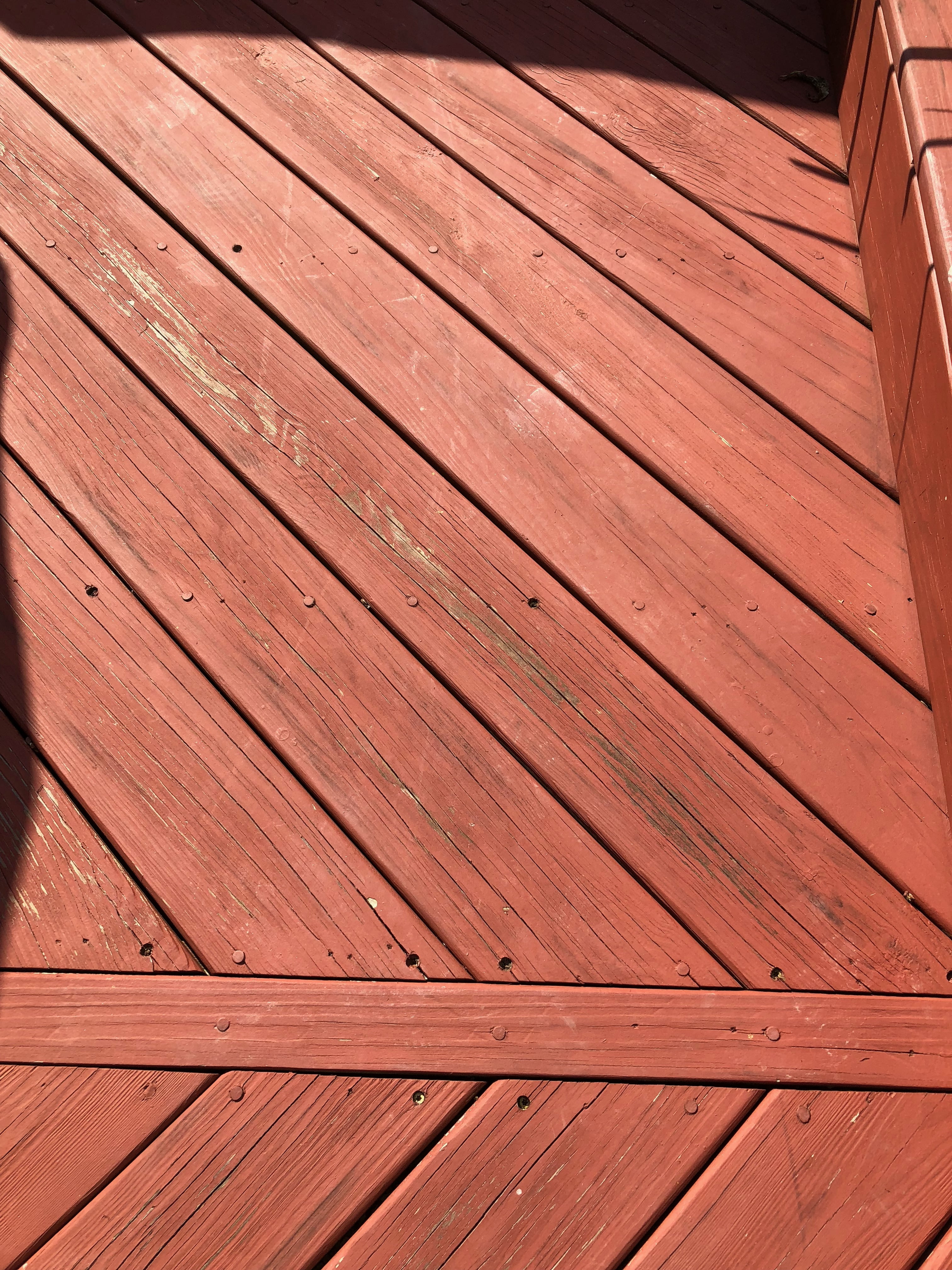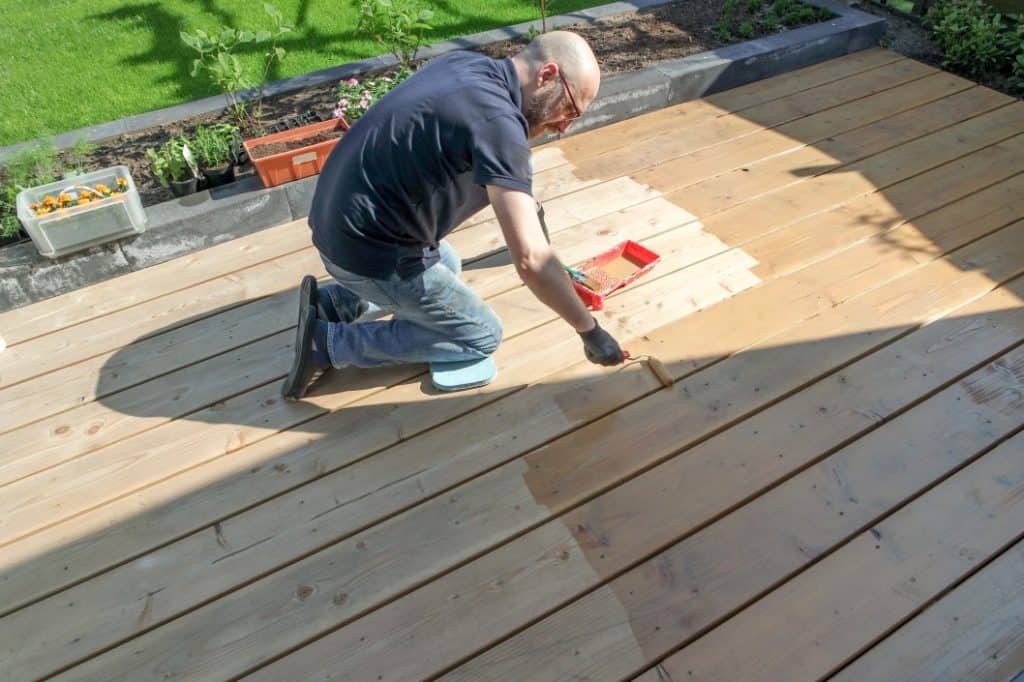If you have a painted deck and you want to change the color, you can stain over the paint. The process is not difficult, but it is important to follow the proper steps to ensure that the new stain will adhere to the old paint. First, you will need to sand the surface of the deck to rough it up and create a surface that the new stain can grip.
Next, you will need to clean the deck with a power washer or a garden hose with a high-pressure nozzle. Once the deck is clean, you can apply the stain. Be sure to follow the directions on the can of stain, and apply it evenly to the surface of the deck.
- If your deck is in good condition and you want to simply change the color, you can do so by sanding down the current paint job and applying a new stain
- If your deck is in poor condition and you want to improve its appearance, you may need to power wash and sand the surface before staining
- Once you have prepared the surface, choose the stain color you want and apply it evenly with a brush or roller
- Allow the stain to dry completely before walking on the deck or placing furniture on it

Credit: www.deckstainhelp.com
How do you stain a deck that has been painted?
It’s not uncommon for a deck to be painted instead of stained. While paint offers protection from the elements, it doesn’t allow the wood to age naturally and can be difficult to remove if you decide to stain the deck later on. If you’re ready to stain your painted deck, the process is relatively simple.
With the right supplies and a little elbow grease, you can have a stained deck that looks great and offers protection from the elements. Here’s what you’ll need to stain your painted deck:
- Paint stripper
- Sandpaper
- Stain
- Paintbrush or roller
- Tarp or drop cloth
First, you’ll need to remove the paint from the deck. This can be done with a paint stripper or a sander.
If you’re using a paint stripper, be sure to follow the manufacturer’s instructions carefully. Once the paint is removed, sand the deck to create a smooth surface. Next, choose the stain you want to use.
There are a variety of stains on the market, so take some time to choose the right one for your needs. Once you’ve selected a stain, apply it to the deck using a paintbrush or roller. Be sure to follow the manufacturer’s instructions for best results.
Finally, protect your deck from the elements by covering it with a tarp or drop cloth. This will help keep the stain from fading and will make cleanup easier. Staining a painted deck is a relatively easy process. With the right supplies and a little elbow grease, you can have a stained deck that looks great and offers protection from the elements.
Can you put wood stain over paint?
It’s possible to put wood stain over paint, but it’s not recommended. The stain won’t be able to penetrate the paint, so it will sit on top of the paint and won’t create the desired effect.
Can you put exterior stain over paint?
It is possible to put exterior stain over paint, but it is not recommended. The main reason for this is that paint is not as breathable as stain, so the stain will not be able to penetrate the paint and will not adhere as well. Additionally, the paint will likely be a different color than the stain, so the final result will not be as even.
If you do decide to stain over paint, be sure to use a stain that is designed for that purpose.
Can you solid stain over paint?
It is possible to solid stain over paint, but it is not recommended. Solid stain is designed to penetrate into the wood, whereas paint forms a layer on top of the wood. If you solid stain over paint, the solid stain will not be able to penetrate into the wood and will not achieve the desired look.
PEELING DECKS. Put Stain OVER Old Paint
Can you use a stain over paint?
If you’re looking to add a bit of color to your home, you may be wondering if you can use a stain over paint. The answer is yes! Stain can be a great way to add depth and interest to your space.
Before you begin, it’s important to make sure that the surface you’re working with is clean and free of any dirt or debris. Once you’ve done that, you can apply the stain of your choice.
One thing to keep in mind is that stain can be a bit unpredictable.
You may want to test it out on a scrap piece of wood or fabric before applying it to your project. This will help you get a feel for how the stain will interact with the paint.
Once you’ve applied the stain, you can add a topcoat of sealer to protect it.
This will also help to ensure that the color remains true over time.
So, if you’re looking to add a little something extra to your next painting project, consider using a stain. With a little care and attention, you can create a beautiful and unique finish that will add personality to your space.
Can you stain over paint without sanding
It is possible to stain over paint without sanding, but there are a few things you need to do first in order to ensure that the process goes smoothly. First, make sure that the paint is in good condition and is not peeling or flaking off in any way. If the paint is in poor condition, sanding will be necessary before staining.
Next, clean the surface of the paint with a degreaser or TSP solution to remove any grease or dirt that may be on the surface. Once the surface is clean, apply a stain-blocking primer to the area before staining. This will help to prevent the stain from soaking into the paint and will give you a more even finish.
Finally, when staining, use a brush or rag and work in small sections to avoid creating any streaks or lines.
Can you stain over deck correct
If you’re looking to give your deck a fresh new look, you may be wondering if you can simply stain over the existing deck correct. The good news is that you can, in fact, stain over deck correct. However, there are a few things you’ll need to keep in mind in order to ensure that your new stain job looks great.
First, it’s important to thoroughly clean the surface of your deck before applying any new stain. This will help to ensure that the new stain adheres properly and doesn’t end up looking patchy. You can use a pressure washer or a stiff bristled brush to do this.
Once the surface is clean, you’ll need to sand it down in order to rough up the surface and give the new stain something to grab onto. Be sure to use a fine-grit sandpaper so you don’t damage the wood.
Once the surface is sanded, you can go ahead and apply your new stain.
Be sure to follow the directions on the can carefully in order to achieve the best results.
With a little bit of time and effort, you can easily stain over deck correct and give your deck a whole new look. Just be sure to take your time and prep the surface properly before applying the new stain.
Best paint for previously painted deck
If you’re planning on repainting your deck, you’ll want to choose the best paint for painted deck. After all, you want your deck to look its best for years to come. There are a few things to consider when choosing deck paint.
First, you’ll want to choose a paint that is specifically designed for decks. This will ensure that the paint will adhere well and be durable. You’ll also want to consider the color of your deck.
If you want a fresh look, you might choose a different color than what is currently on your deck. But if you want to maintain a natural look, you’ll want to choose a similar color. Finally, you’ll want to consider the type of paint.
There are oil-based paints and water-based paints. Oil-based paints are more durable, but they can be more difficult to apply. Water-based paints are easier to apply but they may not last as long.
No matter what type of paint you choose, be sure to follow the manufacturer’s instructions for the best results. With a little time and effort, you can have a beautiful deck that will last for years.
Conclusion
If you’re looking to give your deck a new lease on life, staining over painted deck is a great option. Although it may seem daunting, with a little elbow grease and the right products, you can achieve professional results.
The first step is to sand down the deck to create a smooth surface for the stain to adhere to.
Once you’ve sanded, be sure to vacuum up any dust and debris.
Next, it’s time to select your stain. There are a variety of stains on the market, so be sure to choose one that is specifically designed for decks.
Once you’ve chosen your stain, apply it according to the manufacturer’s instructions.
After the stain has dried, you may want to apply a sealer to protect it from the elements. There are a variety of sealers on the market, so be sure to choose one that is specifically designed for decks.
With a little effort, you can easily stain over your painted deck and give it a whole new look.

